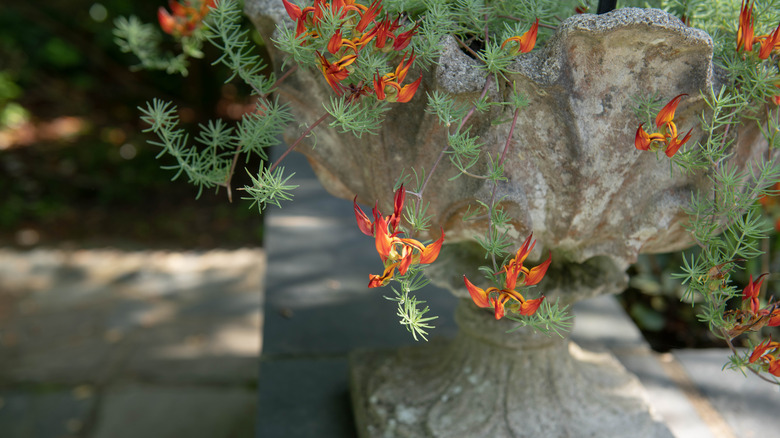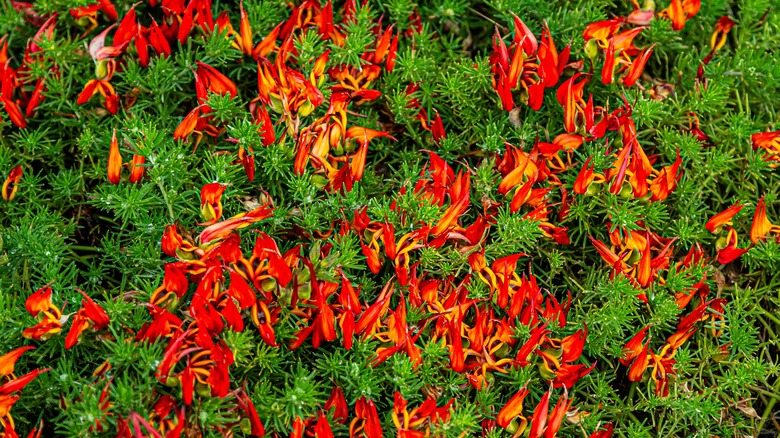The Unusual Yet Gorgeous Flower You'll Want To Grow In A Container. Here's Why
Are you tired of the same old petunias and marigolds in your garden? Looking for something that will make your neighbors do a double-take? Well, let this be your introduction to the parrot's beak, a flower so unique and stunning that it might just become your new favorite. The parrot's beak, scientifically known as Lotus berthelotii, is a showstopper. This exotic beauty originally hails from the Canary and Cape Verde Islands. With blooms that resemble the beak of a parrot — hence the name — these flowers come in fiery, showy shades of red, burgundy, and yellow. They typically blossom in late spring and early summer, adding a pop of color when many other plants are just getting started.
Gardeners love the parrot's beak not only for its striking appearance but also for its trailing growth habit, which makes it perfect for hanging baskets and container gardening. It's no wonder this plant has gained popularity recently; it's the floral equivalent of a Hollywood star making a grand entrance at a gala. If you're itching to get your hands on some seeds or young plants, you can find them at specialty nurseries or online retailers.
How and where should you plant parrot's beak?
Now, before you start scattering these beauties all over your garden, you'll want to pay attention to how and where you plant them. Parrot's beak can fit the definition of an invasive plant, meaning it has the potential to spread and outcompete native plants if left unchecked. Imagine inviting a charming but overenthusiastic friend to a party — fun at first, but soon they're taking over the dance floor and raiding the snack table. That's parrot's beak in a nutshell.
Luckily, it is fairly easy to keep this exuberant plant under control, mainly by allowing it to grow in containers or hanging planters rather than wild in your garden. Planting it in a container is a pretty easy process. Choose a pot with good drainage, fill it with well-draining soil (a mix of potting soil and sand works wonders), and place the plant in a sunny spot.
If you have decided to go for a hanging planter, the process is similar. Make sure that the planter has drainage holes, line it with a basket liner, pour in the same well-draining soil mix, add your parrot's beak, then hang it where it can bask in plenty of sunlight. The trailing stems will spill over the edges, creating a cascading effect that's nothing short of stunning.
How do you care for your parrot's beak long term?
Now that you've got your parrot's beak all settled in, let's talk about how to keep it happy and healthy. This plant may look exotic, but it's surprisingly low-maintenance and reasonably drought-resistant. First and foremost, parrot's beak loves the sun. Aim for at least six hours of direct sunlight each day to keep those vibrant blooms coming.
When it comes to watering, think of this plat like a cactus. Parrot's beak doesn't need much moisture, so allow the soil to dry out between waterings, which typically means watering every other week or so. Overwatering can lead to root rot, which is a one-way ticket to plant heaven. Fertilize sparingly; a balanced liquid fertilizer once a month during the growing season should do the trick.
Pruning and deadheading is a must for your parrot's beak. Trim back any leggy or straggly stems to encourage bushier growth and more blooms. Deadheading, or removing spent flowers, will also help prolong the blooming period. And finally, keep an eye out for pests like aphids and spider mites. A gentle spray of soapy water can usually take care of any unwelcome visitors.


